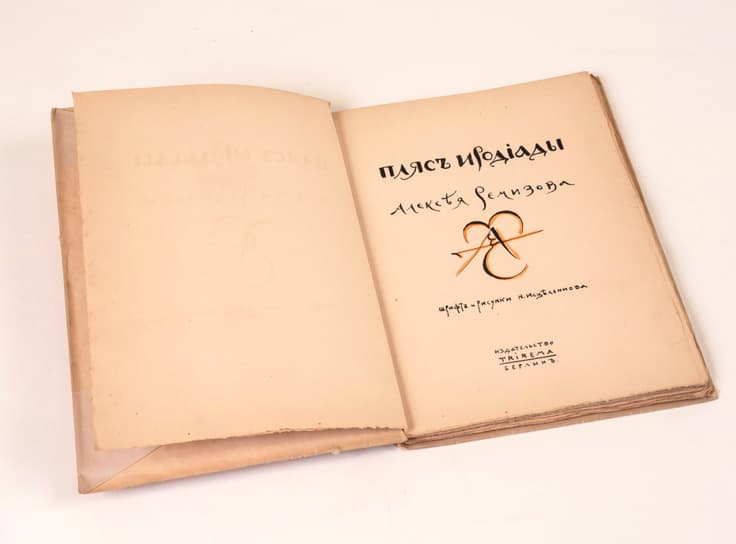REMIZOV A. M. (1877-1957) Plyas Irodiadi [Dance of Herodias]. Berlin: Triema, 1922 - [61] p.: ill.; 20,3х15 cm. Hand-painted by Iscelennov.
Lot 711
22 00025 000
Edition of 500 numbered copies, of which 50 are hand-coloured by the artist. Uncoloured copies are numbered with Arabic numerals from 1 to 400, and 50 dedicated copies – with numerals from «Im. 1» to «Im. 50». The coloured copies are numbered with Roman numerals from I to XXX, and 20 dedicated copies are numbered «Im. I» to «Im. XX».
The author’s signature is reproduced on the title page.
Complete lithographed edition: fonts and drawings in the book are lithographs by the artist Nikolai Iscelennov.
The present lot is hand coloured by the artist and is from the limited edition of thirty, with the number XIX signed by N.I. Iscelennov, in the publisher’s illustrated cover.
Very good condition, some minor soiling.
One of the rarest books by Alexey Remizov.
‘Plyas Irodiadi’ (The Dance of Herodias) is a story about the events of the Russian Revolution in the form of folkloric stylisation. Since the 1910s, Remizov has employed the method of stylisation, creating hagiographies of saints, Apocrypha, and didactic parables. Later, in emigration, Remizov moved towards a religiously charged myth, creating his fictional world in which he seeks to escape from the chaos of mundane routine. Both in his work and in his life, he seeks to subjectively alter everyday life in line with the ideal norm which he sees in Old Russian canonised and apocryphal hagiographies. He expressed this not solely in the stylistics of his works, but even in the stylisation of his manner of handwriting (A. Borovkov, «Notes on the Russian Avant-garde», Moscow, 2007, pp. 65-66).
Aleksei Mikhailovich Remizov (1877-1959) was a novelist, artist and calligrapher. One of the brightest writers in Russian literature. He emigrated in 1921 and lived in Paris. All his books, including those published in Berlin between 1920 and 1923, were banned and were kept in special custody during the Soviet era.
‘The Dance of Herodias’ is a story about the events of the Russian Revolution in the form of folkloric stylisation. Since the 1910s, Remizov has employed the method of stylisation, creating hagiographies of saints, Apocrypha, and didactic parables. Later, in emigration, Remizov moved towards a religiously charged myth, creating his fictional world in which he seeks to escape from the chaos of mundane routines. Both in his work and in his life, he seeks to subjectively alter everyday life in line with the ideal norm which he sees in Old Russian canonised and apocryphal hagiographies.
Nikolai Ivanovich Iscelennov (1891-1981) was an architect, graphic artist and book illustrator. He designed churches and civil constructions in France and Belgium. Between 1921-1924 he lived in Berlin. He was a member of the board of the Dom Iskusstva («House of Art»). In 1922 he published albums of drawings «Moscow Types», the book Plyas Irodiadi [«Herodias’ Dance»] by A.M. Remizov, and in 1923, he published «Berlin Street Types» and autolithographed book «Ecclesiastes» with the family publisher «Trireme» in 1922. He also created illustrations for «The Queen of Spades» by Alexander Pushkin (1922).
"






